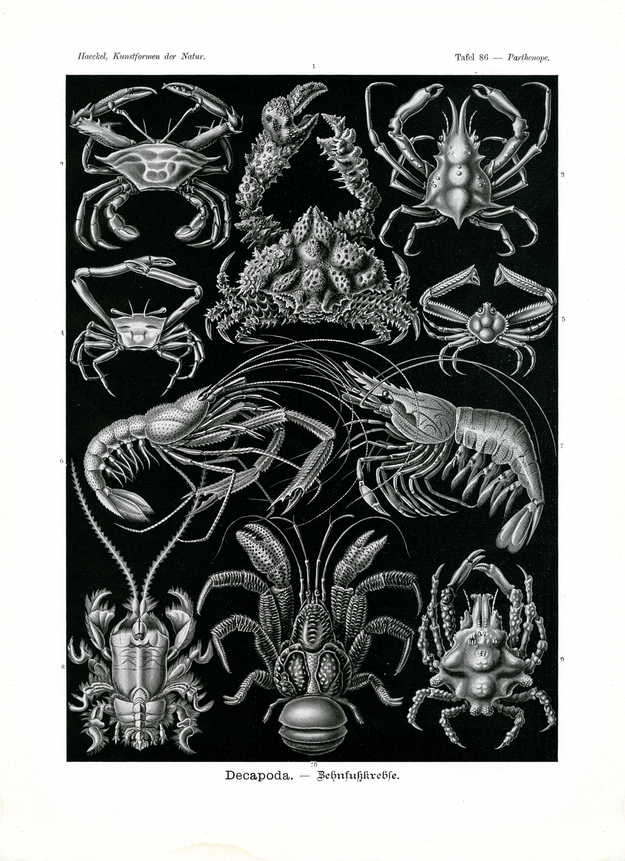Translation of the original German introduction by Ernst Haeckel:
Phylum of Articulata (Gliedertiere); - main class of Crustacea (Krustentiere); - class of Caridonia (Krebstiere); - legion of Thoracostraca (Panzerkrebse); - order of Decapoda (Zehnfußkrebse).
The order of the ‘ten-footed’ or ‘ten-foot-crabs’ (Decapoda) comprises the biggest, most perfect and developed among the true crabs. They belong to the varied subclass of higher Caridonia summarized under the name of ‘superior crustaceans’ (Malacostraca). Although this group comprises more than four thousand distinct species and even though they are highly diverse in their outer body shape and internal organization, the number of parts of their bodies remains twenty constantly, and each body part (Somit or Metamer) carries a pair of limbs – except for the last one, the tail fan or Telson. The striking consistency in the organization of the parts can be explained with heredity from a common original form while, at the other hand, the great variety of shape becomes understandable considering adaptation to diverse living forms and -conditions.
The subclass of Malacostraca breaks up into two legions, the ‘sitting eyes’ (Edriophthalma) and the ‘stalked eyes’ (Podophthalma); in the former the eyes are rigidly fixed to the head (Amphipoda and Isopoda), in the latter they are resting on movable stalks (Stomatopoda and Decapoda). The best known representative of Decapoda is our common crayfish (Astacus fluviatilis), the biggest among all native articulate animals. Closely related are the big lobsters and the small shrimps (Caridina, fig. 6, 7). In all Decapoda the 20 body parts are distributed in a similar way into three main parts of the body: 5 parts of the head (Caput), 8 of the chest (Thorax) and 7 of the abdomen (Abdomen). On the dorsal side head and chest have coalesced into a uniform ‘head-chest-shell’ (Cephalothorax) whereas the seven abdominal rings remain free. Due to division of tasks, the 19 pairs of limbs break up into 2 pairs of ‘sensing horns’, 3 pairs of jaws, 3 pairs of ‘jaw-feet’, 5 pairs of ‘see-ride-feet’ (the anterior ones with pincers), and 6 pairs of abdominal feet.
The order of Decapoda is differentiated into three suborders: the first comprises the ‘long-tailed’ (Macrura) with long, fully developed abdomen (crayfish and prawn belong here, fig. 6, 7); secondly, the ‘short-tailed’ (Brachyura) with short abdomen that is turned to the ventral side of the ‘head-chest’ (crabs and ‘sea-spider’ belong here, fig. 1-5, 10); thirdly, the ‘middle-tailed’ (Anomura), positioned in between the other two (fig. 8, 9). Example for the latter are the peculiar hermit crabs or ‘Bernhards-crabs’ that have adopted the weird practice to encapsulate their vestigial, soft abdomen in an empty snail shell. One of these Paguridea, the terrestrial Indian ‘palm-thief’ (Birguslatro, fig. 9), mainly feeds on coconuts that it opens very skillfully. The development of most Decapoda is connected with remarkable transformations; some of the peculiar larvae that emerge from it are illustrated on plate 76. A distinctive representative of short-tailed crabs is the ‘Zoea-larva’ with a pair of extremely big eyes (plate 76, fig. 6).
Translation by VR Translators Bangalore
We've scanned the original lithography at 1200dpi on the Epson A3 scanner of A3 scanner huren. You can download a 400dpi JPEG here.
